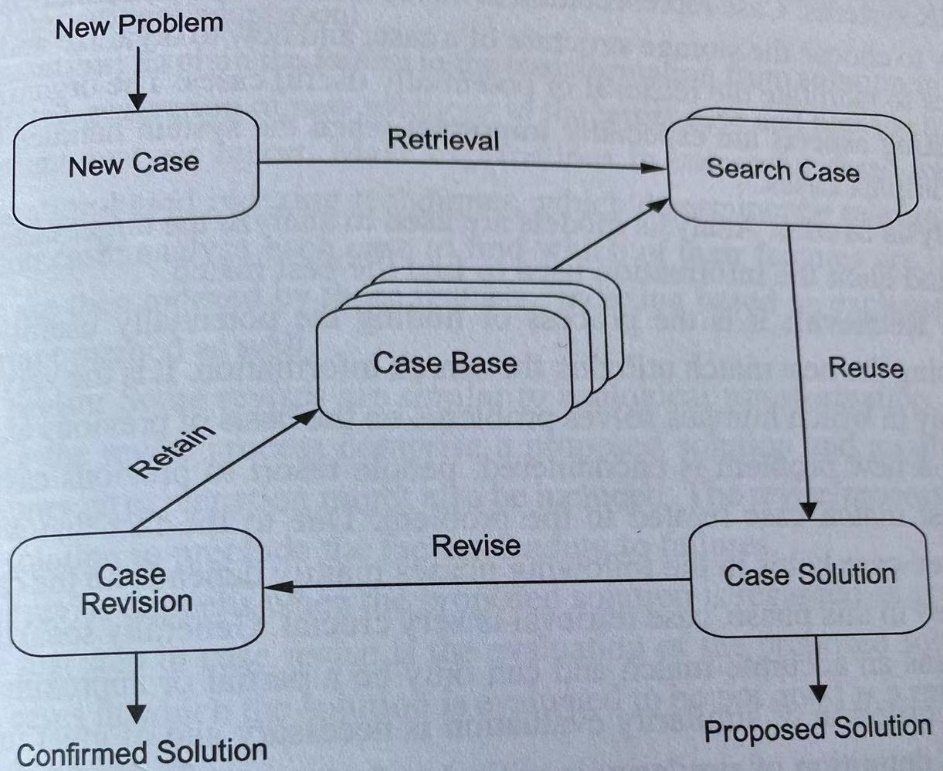In case-based reasoning (CBR), the current problems or situations are called target cases, and the memorized problems or situations are called base cases. Roughly speaking, case-based reasoning is a strategy to obtain the source case in memory from the prompt of the target case, and use the source case to guide the solution of the target case. Knowledge representation in case-based reasoning is based on case, and the acquisition of case is easier than rule acquisition, which greatly simplifies knowledge acquisition. Reusing the past solution results instead of deriving from scratch can improve the efficiency of solving new problems. The experience of success or failure in the past can guide how to achieve success or avoid failure in the current solution, which can improve the quality of the solution. For those problems that can be solved by calculation and derivation, there is no or no problem at present. For example, case-based reasoning can play a good role in legal precedents.
The process of case-based reasoning mainly includes four stages, which is shown in Figure 1.

Figure 1 The process of case-based reasoning
(1) Case retrieval finds one or more cases that are most similar to the current problem from the casebase. The knowledge base in CBR system is not the rule base in the previous expert system, it is composed of some problems previously solved by domain experts. Each example in the case base includes a general description of the previous problem, that is, scenario and solution. When a new example is merged into the case base, an index of the main features of the example is also established. After accepting a request to solve a new problem, CBR uses similarity knowledge and feature index to find the best examples related to the current problem from the case base. Because the content it recalls (i.e. the quality and quantity of examples obtained) directly affects the effect of solving the problem, this work is more important. It is realized by feature identification, preliminary matching and best selection.
(2) Case reuse reuses the solutions of retrieved old cases into new problems or new cases. By comparing the given questions with the examples in the example library, we can get the differences between the old and new examples, and then answer which answer parts can be reused in the new questions. For the simple classification problem, it only needs to use the classification results of the old paradigm directly for the new paradigm, and it does not need to consider the differences between the old paradigm and the new paradigm. For problem solving problems, we need to deeply understand the domain knowledge, and adjust the problem according to the different examples, which can be some adjustments to a certain item of the whole solution, or fine tune the whole solution. From the perspective of information content of reuse, there are mainly two types: reuse of results and reuse of methods. For the reuse of results, when the answer results of the old example need to be adjusted, it converts various possible solutions in the old example into the corresponding solutions in the new example according to some transformation operation knowledge. The reuse of methods is concerned with the solution of the problem in the old paradigm, rather than the result of its solution. Which method depends on the specific problem.
(3) Example correction when the solution result produced in the reuse stage is bad, it needs to be corrected. The first step of correction is to evaluate the reuse results. If it is successful, it is not necessary to correct it, otherwise errors and deficiencies need to be corrected. The result evaluation can be based on the feedback after it runs in the actual environment, or it can be completed by asking teachers. Waiting for feedback may sometimes take some time, such as the effect of waiting for patients' treatment. However, if it is an online application in engineering, such as the computer steel rolling system, the results can be returned immediately, but if the setting is seriously wrong, it may cause a roll break accident, so it is necessary to check the load of the mill before the actual download. Correcting errors generally involves error detection and finding the cause. Finding the cause is to explain and analyze the error, so as to find out the cause and find the right remedy, that is, modify the cause of the error so that it does not happen again. Of course, the modification can be done either by using the domain knowledge model for self correction or by user input.
(4) When the new problem of example preservation is solved, a similar problem may be formed in the future. At this time, it is necessary to add it to the sample library. This is learning and knowledge acquisition. This process involves selecting which information needs to be retained, and how to organically integrate new cases into the case base, and will involve the knowledge of the organization and management of the case base.
Download File: